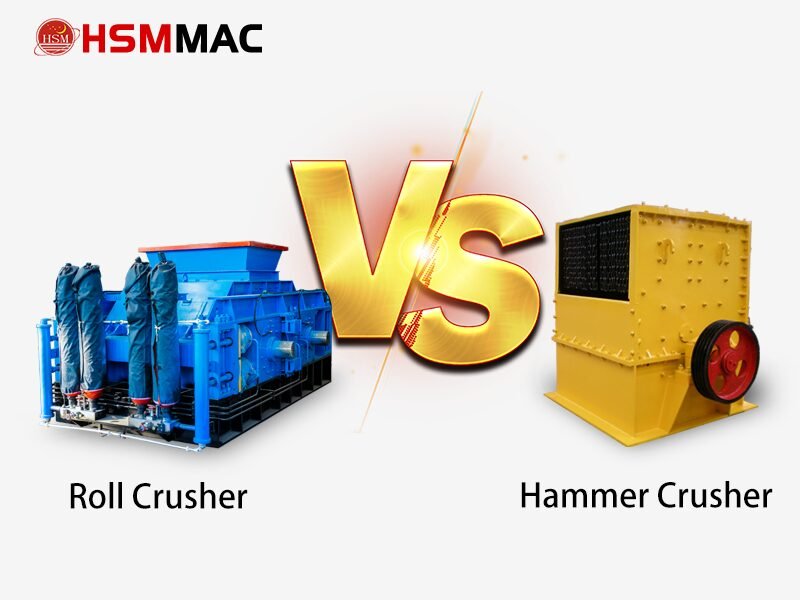Comparative Analysis of Energy Consumption Between Roller Crushers and Hammer Crushers

Based on user-provided search results, here is a detailed comparison of energy consumption between the two types of crushers:
1. Differences in Energy Efficiency and Working Principles
- Roller Crusher
- Crushing Mechanism: Utilizes compression-based crushing (counter-rotating rollers), where energy is primarily used for material compression and shearing, resulting in high energy conversion efficiency.
- Low Energy Consumption: Typical unit energy consumption ranges from 8–13 CNY/ton (Page 3). Specific models like the 2PG610×400 consume only 30 kWh/hour (Page 7), and energy use can be optimized by adjusting roller gaps.
- Energy-Saving Advantages: Compared to hammer crushers, roller crushers reduce energy loss from impact forces and generate less dust, lowering overall energy consumption by over 30% (Page 4).
- Hammer Crusher
- Crushing Mechanism: Relies on high-speed impact crushing, requiring significant power to drive the rotor and hammers, leading to higher energy loss.
- High Energy Consumption: When processing large materials, unit power consumption increases (e.g., the PC800×600 model consumes 45 kW with a throughput of 15–30 tons/hour, Page 11).
- Indirect Energy Costs: Frequent replacement of wear parts (e.g., hammers, grate bars) increases downtime, indirectly raising energy costs.
2. Key Energy Consumption Metrics Comparison
| Criteria | Roller Crusher | Hammer Crusher |
|---|---|---|
| Unit Power Consumption (CNY/ton) | 8–13 | 8–13 |
| Typical Model Energy Use | 2PG610×400: 30 kWh/hour | PC800×600: 45 kW |
| Long-Term Energy Costs | Low (less maintenance, longer lifespan) | High (frequent wear part replacements) |
| Moisture Tolerance | Sensitive (clogging risk with high moisture) | Poor efficiency at moisture >12% |
3. Factors Influencing Energy Consumption
- Crushing Mechanism:
- Roller crushers use static compression, minimizing energy waste, while hammer crushers rely on kinetic impact, leading to higher energy loss.
- Material Properties:
- Roller crushers are suitable for medium-hard materials (e.g., coal, iron ore). Excessively hard materials increase roller wear and energy use.
- Hammer crushers experience accelerated hammer wear when processing hard materials, requiring frequent maintenance and indirectly raising energy costs.
- Product Yield and Over-Crushing:
- Roller crushers achieve near 100% yield (Page 3), reducing re-crushing needs.
- Hammer crushers generate excessive fines, necessitating secondary screening and additional energy input.
4. Selection Recommendations
- Prioritize Roller Crushers:
- Scenarios: Fine crushing of low-moisture materials (e.g., sand production from Guamishi, iron ore processing) with a focus on long-term energy savings.
- Advantages: Lower energy consumption, controllable maintenance costs, and suitability for continuous operation.
- Consider Hammer Crushers:
- Scenarios: Coarse crushing of large materials (e.g., primary limestone crushing) requiring short-term, high-throughput production.
- Note: Higher electricity budgets and wear part replacement costs must be anticipated.
5. Case Studies
- Guamishi Sand Production Project :
- Roller Crusher: Unit energy consumption of 10–15 CNY/ton, with annual operating costs 20%–30% lower than hammer crushers.
- Hammer Crusher: Higher energy use and over-crushing increased screening costs, raising overall expenses.
- Iron Ore Crushing :
- Roller Crusher: Reduced unit energy consumption by 40% compared to hammer crushers, with dust control further lowering environmental energy costs.
Conclusion: Roller crushers significantly outperform hammer crushers in energy efficiency, long-term operational costs, and environmental performance, particularly for fine crushing of medium-hard materials. Hammer crushers are better suited for coarse crushing but entail higher energy and maintenance costs. Final selection should consider material properties, production scale, and energy budget.



